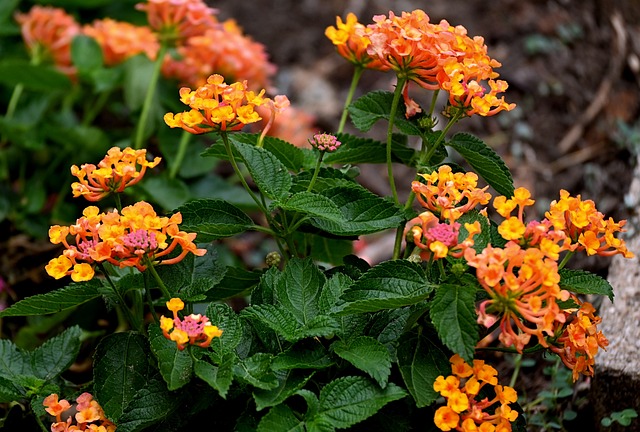In this guide, we’ll walk you through the steps to successfully propagate Lantana, ensuring that you can enjoy its beauty in more areas of your garden.
Understanding Lantana
Before you start propagating, it’s helpful to know a little about Lantana. This perennial plant thrives in warm climates and produces clusters of small, colorful flowers that can be yellow, orange, pink, or purple. It’s drought-tolerant and thrives in full sun, making it an ideal choice for low-maintenance gardens. When properly cared for, Lantana can bloom continuously throughout the growing season, providing vibrant color and attracting pollinators.
Why Propagate Lantana?
Propagating Lantana not only helps you expand your garden but also allows you to share this beautiful plant with friends and family. If you have a healthy Lantana plant in your garden, you can create new plants from it, saving money on nursery purchases. Additionally, propagating your plants can be a rewarding gardening project, giving you hands-on experience with plant care.
The Best Methods to Propagate Lantana
There are a few methods for propagating Lantana, with stem cuttings being the most common and effective. Here’s a step-by-step guide on how to do it:
1. Choose the Right Time
The best time to propagate Lantana is during the spring or early summer when the plant is actively growing. Avoid late summer or fall, as the plants may not root well during the cooler seasons.
2. Gather Your Supplies
You’ll need the following materials:
A healthy Lantana plant
Sharp, clean pruning shears
A small pot or tray with drainage holes
Potting mix or a seed starting mix
Water
A plastic bag or clear plastic dome (optional for humidity)
3. Take Stem Cuttings
Select healthy, non-flowering stems from the Lantana plant. Look for stems that are about 4 to 6 inches long, ideally taken from new growth.
Using your pruning shears, cut the stem just below a leaf node (the point where a leaf meets the stem).
Remove the lower leaves, leaving only a few leaves at the top. This helps reduce moisture loss while the cutting develops roots.
4. Prepare the Cuttings for Planting
If desired, dip the cut end of the stem in rooting hormone. This can help promote faster root development, although Lantana can often root without it.
Fill your pot or tray with potting mix, making sure it’s damp but not waterlogged.
5. Plant the Cuttings
Make a small hole in the potting mix with your finger or a pencil and insert the cut end of the stem into the hole. Firm the soil around the cutting to hold it in place.
Space cuttings a few inches apart if using a larger tray.
6. Provide the Right Conditions
Water the cuttings gently to settle the soil. Ensure that the pot is in a warm location with plenty of indirect sunlight.
To maintain humidity, cover the pot with a plastic bag or a clear plastic dome, ensuring that there’s some ventilation to prevent mold.
7. Care for the Cuttings
Keep the soil consistently moist but not soggy. Check regularly for signs of drying out.
After a few weeks, gently tug on the cuttings; if you feel resistance, roots are forming! This can take anywhere from 2 to 6 weeks, depending on environmental conditions.
8. Transplanting
Once your cuttings have developed a good root system (usually indicated by resistance when tugged), it’s time to transplant them into larger pots or directly into your garden. If transplanting outdoors, make sure to wait until the threat of frost has passed.
9. Care for Your New Lantana Plants
Once transplanted, continue to care for your new Lantana by providing adequate sunlight, water, and occasional fertilization. Watch them grow and flourish as they bring beauty and color to your garden.
Common Issues to Watch for
Root Rot: Ensure your cuttings are not sitting in waterlogged soil. Good drainage is essential.
Pests: Keep an eye out for aphids or spider mites. Treat issues promptly with insecticidal soap if needed.
Legginess: If cuttings become tall and spindly, they may not be receiving enough light. Move them to a brighter location or adjust the covering to ensure they receive adequate indirect sunlight.
Enjoying Your New Lantana Plants

Once your new Lantana plants are well-established, you can enjoy their vibrant flowers and the pollinators they attract. Whether you choose to plant them in garden beds, containers, or as a border plant, Lantana will surely brighten up your outdoor space.
Tips for Growing Healthy Lantana
Sunlight: Lantana loves full sun. Aim for at least 6 hours of direct sunlight each day to encourage healthy growth and blooming.
Watering: While Lantana is drought-tolerant, young plants need regular watering until they are established. Once they are established, you can allow the soil to dry out between waterings.
Fertilization: Use a balanced, all-purpose fertilizer in the spring to encourage healthy growth and flowering throughout the season.
Pruning: Prune Lantana regularly to maintain its shape and encourage new growth. Remove spent blooms to promote more flowers and remove any dead or damaged branches.
Final Thoughts
Propagating Lantana is an enjoyable and rewarding process that can enhance your garden’s beauty while allowing you to create an abundance of this stunning plant. With the straightforward steps outlined in this guide, you’ll find that propagating Lantana can be an easy project that not only adds to your gardening skills but also invites a variety of pollinators into your outdoor space.
As you grow your Lantana plants, you’ll also have the opportunity to share cuttings with friends and family, spreading the joy of gardening and the beauty of these resilient plants.





